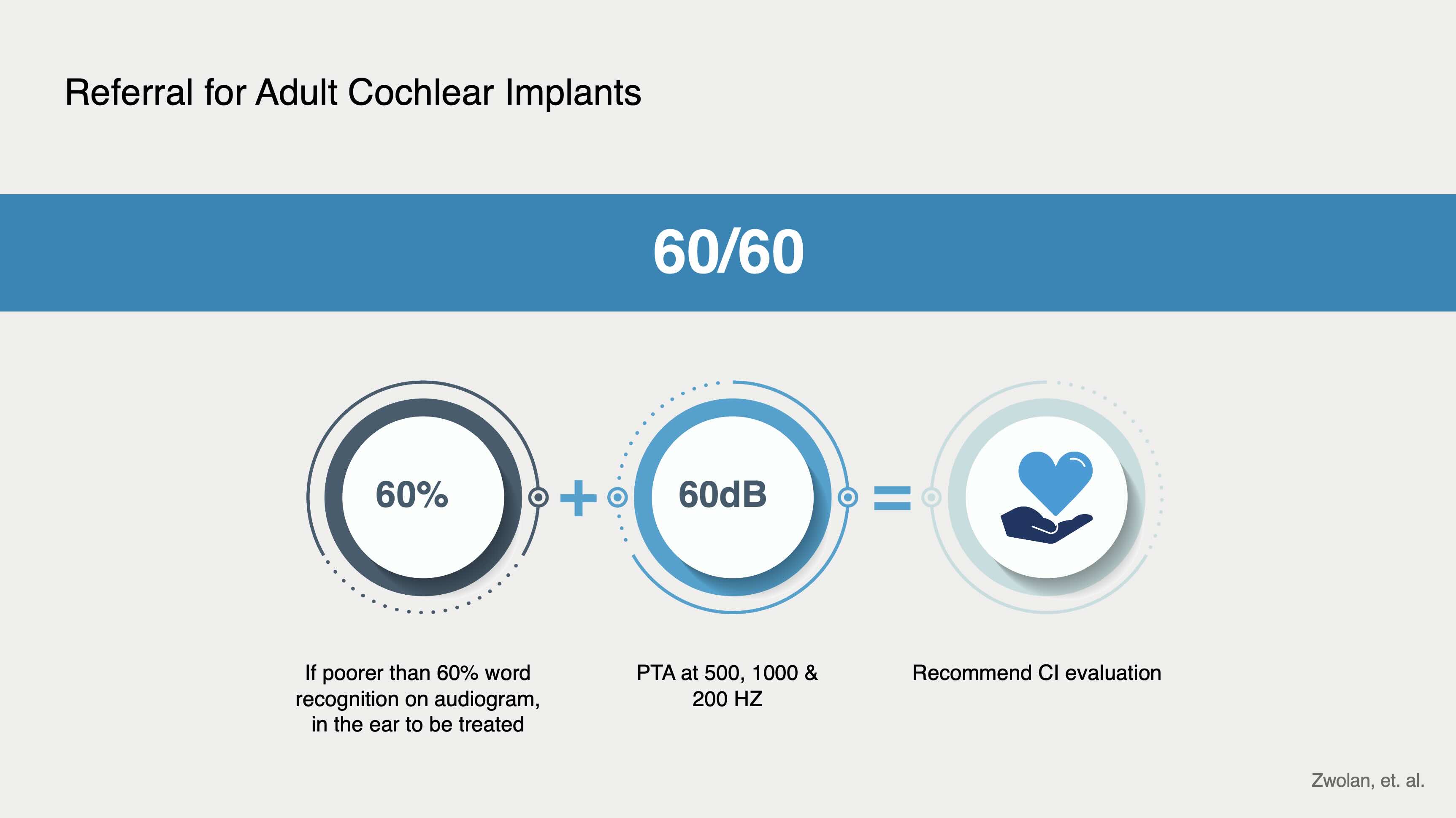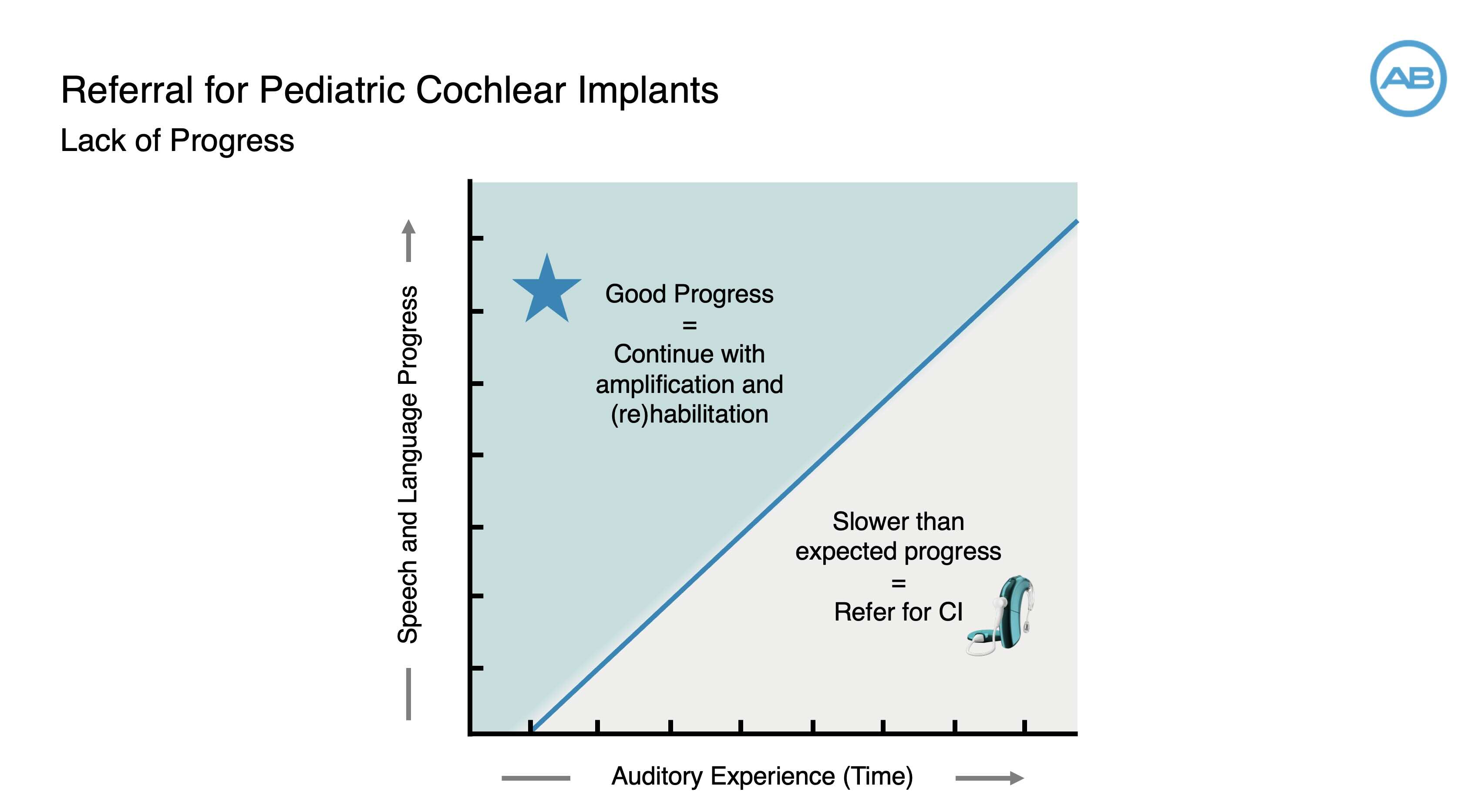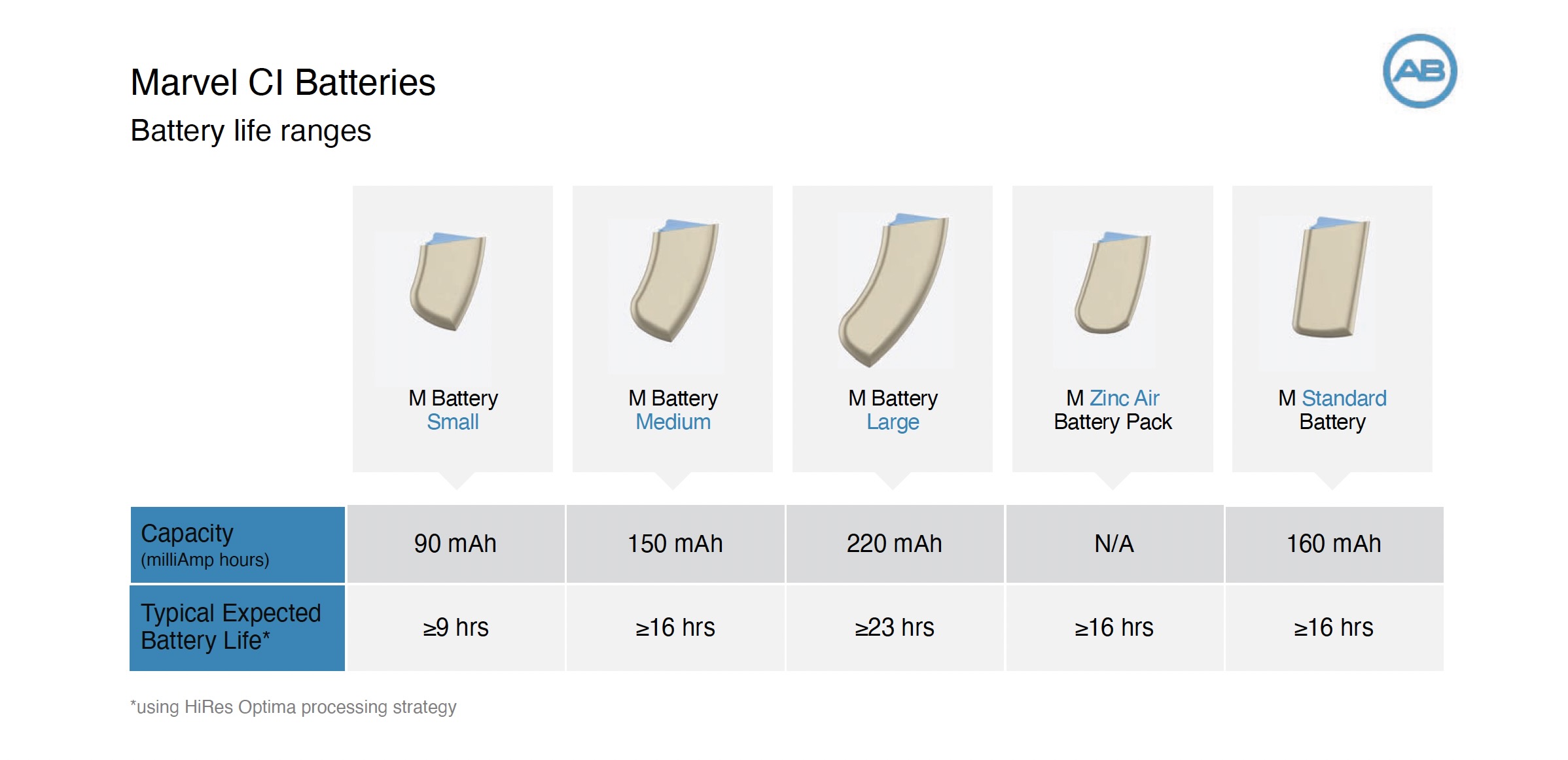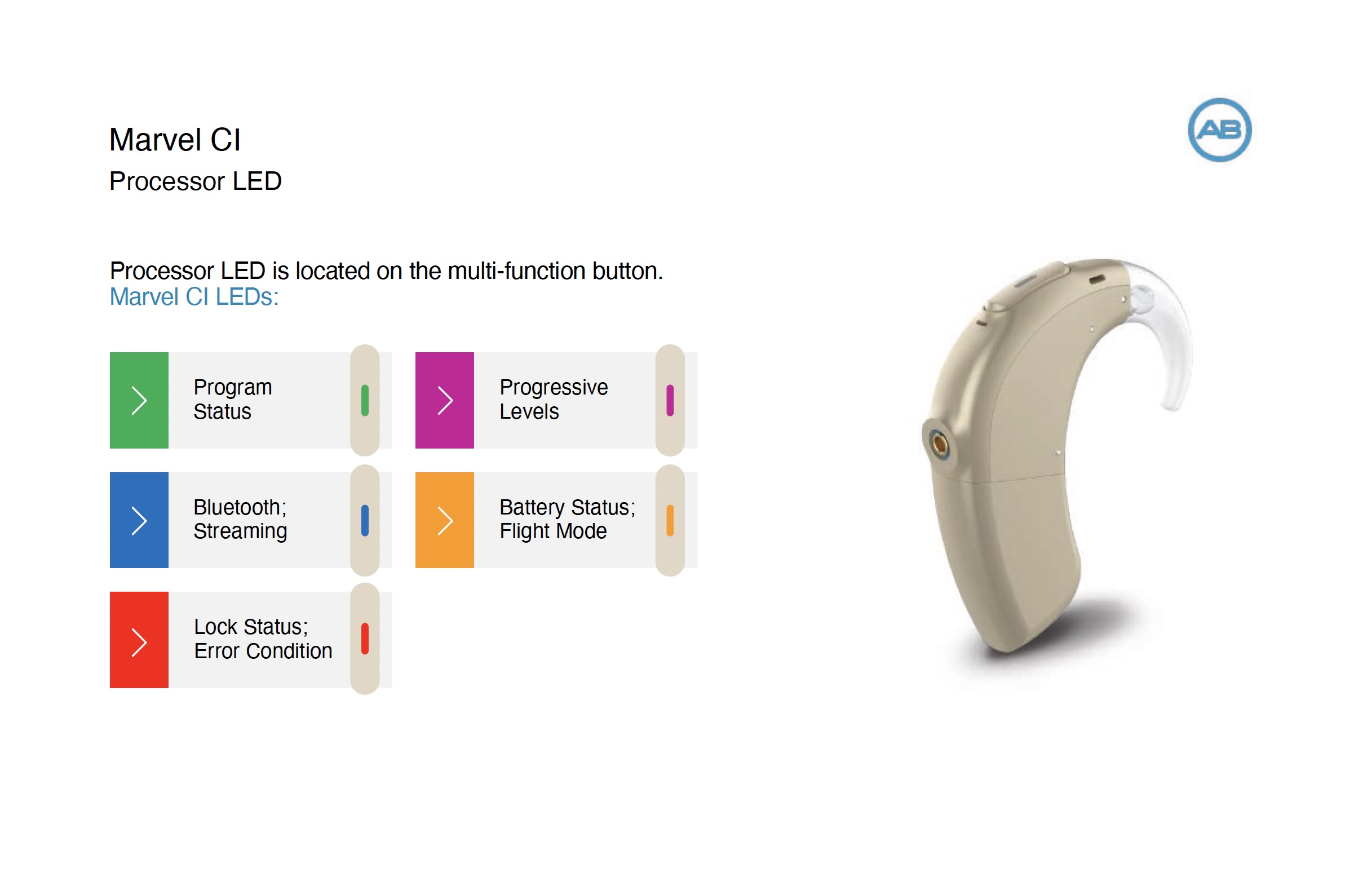Editor’s Note: This text course is an edited transcript of a live webinar.
Learning Outcomes
After this course, participants will be able to:
- Identify the benefits of cochlear implant technology from Advanced Bionics.
- Describe three benefits of Marvel CI.
- Share one resource that can be used clinically in the management of recipients with AB technology.
Before this course, it is encouraged to complete self-paced e-learning modules covering:
- Introduction to Advanced Bionics
- Introduction to cochlear implants
- Overview of cochlear implant candidacy
When to Refer a Patient for a Cochlear Implant
Adults
The 60/60 guideline is used as a screening tool for adult patients.
- Guideline: If a patient is performing poorer than 60% word recognition and has a pure tone average (PTA) at 500, 1000, and 2000 Hertz of 60 decibels or poorer, they are likely a candidate for a cochlear implant.
- This guideline was developed through the research of Terry Zwolan and has been widely adopted in North America. It is a useful tool for hearing healthcare providers to determine when to refer an adult patient for a cochlear implant evaluation, especially when hearing aids are not performing well. This guideline is primarily applicable for English-speaking populations.

Figure 1. Adult Referral Guidelines for Cochlear Implants.
Pediatrics
A child should be referred for a cochlear implant evaluation if they are making limited progress in developing speech and language with appropriately fit hearing aids.
- Children should make month-over-month progress with appropriately fit amplification and progress with rehabilitation goals.
- Slower than expected progress is a trigger to consider a cochlear implant evaluation.

Figure 2. Pediatric Referral Guidelines for Pediatric Populations.
Advanced Bionics: Our Mission
Advanced Bionics empowers patients by developing technologies and services that help people with hearing loss achieve their full potential. AB leads in innovation, offering unmatched performance, exceptional sound clarity, adaptability, and connectivity. Our solutions help users hear more, do more, and live more, creating powerful connections with their world.
AB is part of the Sonova family, which includes the sister brand Phonak. Leveraging shared DNA, AB has created the world's first cochlear implant solutions that are truly unique. This partnership allows for:
- Linked two-ear hearing solutions
- Universal Bluetooth connectivity
- Integrated Roger technology
- Shared accessories that work seamlessly together
AB is excited to leverage Phonak's work in artificial intelligence, deep neural networks, and digital solutions to continue improving the hearing experience. AB aims for impactful performance, focusing on allowing users to do more now and in the future.
For over 30 years, AB has achieved many world-firsts and groundbreaking innovations.
- Today, Marvel CI is rated as the most performance-focused, flexible, and connected cochlear implant on the market.
- The Sky CI Marvel is the first cochlear implant sound processor specifically designed for children.
- AB is on its fourth generation of HiResolution sound with unique signal processing that improves speech understanding, even in difficult listening environments.
- Advanced DigiCare tools like AB ListenFit, rehab resources, and Remote Programming are designed to make professional jobs easier and more efficient, allowing for better patient care beyond the office.
Advanced Bionics focuses on building powerful connections between clinicians and patients, and between patients and the world.
Introduction to Marvel CI Solutions
Advanced Bionics welcomes Olivia Piper, AuD, an audiologist at Yale School of Medicine, to share her clinical experience with Marvel CI Solutions.
Audiologist's Role in Device Selection
Independent research from Vanderbilt University shows that audiologist recommendations significantly impact patient choices. A primary factor in choosing a cochlear implant is technology, including compatibility with hearing aids and integration of Bluetooth and FM devices.
This workshop will provide an overview of AB's technology, specifically Marvel CI, and its benefits and features to help audiologists counsel patients as they decide on the best technology for them.
Primary Components of Marvel CI
There are four main components to Marvel CI:
- Processor: The main unit of the cochlear implant.
- Detachable M Battery: A rechargeable battery.
- T-Mic: Connected to the ear hook.
- Slim headpiece (Slim HP): Integrated into one piece with a cable.
Detailed Component Breakdown:
- Processor Microphones: The processor has two inlet microphones that allow for directionality and work with the T Mic to provide enhanced listening environment detection. These microphones help reduce wind and hair noise and do not require microphone covers.
- T-Mic: Exclusive to Advanced Bionics, the T-Mic utilizes the ear's natural shape to improve hearing in noise. It includes a mic saver component to protect it from dirt, dust, and debris. The T-Mic is available in various sizes for optimal fit. Clinicians can explain it as mimicking natural ear-level hearing.
- Multi-Function Button: The Marvel CI processor features a multi-function button, similar to Phonak hearing aids, which can be programmed to control various commands. Manual controls include volume changes, program changes, and streaming signal adjustments. Pressing the top or bottom of the toggle will cycle programs forward.
- Slim HP (Headpieces): These are thin, streamlined devices with an integrated cable that connects to the processor. They are available with or without an integrated microphone and are interchangeable with standard or 3D magnets. They are also backwards compatible with multiple internal devices.
- Components of Slim HP:
- Magnet Well: Where the magnet attaches to the headpiece.
- Color Cap: Sits on top of the magnet to hold everything in place.
- Slim HP are available with and without integrated microphones, and varying lengths of the processor cable connector are available.
- Components of Slim HP:
Battery Options
Marvel CI offers a portfolio of battery options to balance comfort, wearability, and battery life.
- Patient Counseling: To determine the best battery type, ask patients how long they plan to wear their processor when away from home.
- A large battery offers greater than or equal to 23 hours of battery life.
- A small battery offers about 9 hours of battery life.
- Consider previous hearing aid experience: if a patient found a larger hearing aid uncomfortable, a small battery might be a better fit.
- Some batteries are curved for behind-the-ear fit, while others are straight, based on patient preference.
- Battery Charger: The charger is intuitive to use. LED lights are blue when charging, green when fully charged, and red for errors.

Figure 3. Marvel CI Battery Ranges
Compatibility and Color Options
- Marvel CI is compatible with all internal devices since 2001.
- Color Options (Naida CI M): Various color options are available, often suggested to match hair color for discretion.
- Sky CI M (Pediatric): The Sky CI M was designed specifically for children, recognizing their different listening needs and evolving development. It offers exceptional hearing performance and comes in fun colors to excite children about wearing their processor.
- Adults and Pediatric Colors: Adult patients can also request Sky CI M colors.
Retention Options
AB offers various retention options for flexibility, especially as children grow. These can also be beneficial for adults.
M Snuggie: A soft silicone loop that connects around the processor and ear, helping it stay in place.
M Retention Cuff: A plastic cuff that snaps onto the processor with a moldable piece to go under the pinna, aiding retention.
M Wearing Clip: Allows the processor to be worn off-ear. This is useful for situations where the on-ear placement is problematic, such as activities like yoga.
Features and Benefits of Marvel CI
AutoSense OS: This feature uses artificial intelligence to analyze and classify acoustic environments. It automatically adjusts the processor, eliminating the need for constant manual adjustments by the patient, providing a more natural listening experience. It creates over 200 distinct settings to match the recipient's sound environment.
Example: In a quiet street, it focuses on environmental sounds for safety. In a crowded restaurant, it shifts focus to speech, reducing background noise.
Many audiologists familiar with Phonak hearing aids will recognize AutoSense.
AutoSense Sky 3.0: An operating system uniquely designed for children's listening situations, automatically optimizing the child's sound processor. This reduces the burden on parents/caregivers for making adjustments.
Wireless Connectivity: Marvel CI's portfolio offers extensive wireless connectivity options for both pediatric and adult populations, largely due to the partnership between Advanced Bionics and Phonak.
Compatible with Phonak devices like the Roger On and Roger Clip-On Mic, and wireless Phonak accessories like the Phonak Remote Control or Phonak TV Connector.
World's First Waterproof Battery Option: The M Waterproof Battery is an off-the-ear battery pack with its own battery life.
It can be worn with a wearable arm cuff and a long cable to the headpiece.
The two waterproof solutions are the Waterproof Battery and the Slim HP AquaMic.
Provides an off-the-ear wearing option with a built-in rechargeable battery.
Requires programming an off-ear compatible program as microphones are on the headpiece.
Does not conflict with other on-ear medical devices (glasses, masks, oxygen).
IP rating of 68, meaning it can be submerged beyond 1 meter for over 30 minutes.
Appropriate Environments: All-day use for small pediatric patients, active patients (swimming, snorkeling, skiing, outdoor adventures), and patients working in dusty/debris-filled environments (farm, construction site) or playing on playgrounds.
Allows streaming audio directly from Bluetooth-enabled devices, Roger microphones, Roger Partner/Phonak Partner mic, or a Phonak TV connector. This is useful for activities like swimming lessons, where an instructor can speak directly into a Roger microphone to improve hearing over background noise.
RogerDirect and Integrated Bluetooth Classic: Enables direct streaming without an intermediate device, allowing for hands-free calling and connection to various Bluetooth-enabled devices (phones, tablets, laptops). This simplifies technology interaction and allows patients to easily listen to media, audiobooks, or participate in virtual meetings.
Comfortable and Discreet Shape: The curved design of the processor allows it to sit comfortably behind the pinna, improving retention.
Fitting and Adjustments of the Physical Device
Magnet Kits
Clinics are equipped with magnet kits containing both standard and 3D compatible magnets.
Magnet Strength: Magnets are numbered 1 (weakest) to 7 (strongest) to indicate strength. Regularly check magnet strength on the patient's head. If pain or redness is noticed at the magnet site, reduce the strength.
Compatibility: Slim HP is compatible with both standard and 3D magnets.
Standard magnets are black; 3D magnets are blue.
3D Magnet Alignment: 3D magnets are labeled on top with an arrow indicating the direction for alignment within the magnet well.
Color Caps:
Small/Standard Color Cap: Compatible with standard magnets 1-5 and 3D magnets 1-4. Available in all color options.
Large Color Cap: Used for standard magnet sizes 6-7 and 3D magnet sizes 5-7 due to taller magnet size. Only available in adult color choices.
Children (ages 3 or younger): The large color cap is not recommended for children ages 3 or younger, as it and the Slim HP magnet could become displaced if dropped.
Removing the Color Cap: Use the removal tool, aligning it with the arrow on the color cap, and work around the perimeter to pop it off. Advanced Bionics has YouTube videos demonstrating this.
Slim Headpiece Options
There are three Slim Headpiece (Slim HP) options available:
Slim Headpiece: Designed for on-ear use with Naida CI. It does not have an integrated microphone.
Slim Headpiece Mic (Slim HP Mic): Designed for off-ear use. It is 30 centimeters long and has an integrated microphone. Patients can wear the processor clipped to their shirt, with the cable traveling up to the magnet site.
AquaMic: Designed to work with the M Waterproof Battery. It is a waterproof microphone for hearing in wet environments.
Ear Hook Options
Marvel CI offers several ear hook options:
Standard Ear Hook: No microphones. Available in two sizes, with or without an earmold retention grip.
M or Marvel T-Mic: Available in three sizes. Features T-Mic Detect.
M Acoustic Ear Hook: Available for right and left ears in five sizes. Indicated for patients with residual hearing who can benefit from electro-acoustic stimulation. Uses Phonak SDS 4.0 and P receivers, adapted for Marvel CI.
T-Mic Detect: This feature ensures optimal hearing even if the T-Mic is damaged or dirty. The active mic continually compares microphone inputs between the T-Mic and the processor mics. If there's an issue with the T-Mic, it automatically switches to the processor mics. If a standard or acoustic ear hook replaces the T-Mic, it will also switch to processor mics. When switching back to processor mics, it applies "real ear sounds" to mimic the T-Mic's sound.
Device Checks and LEDs
AB Remote App: A great tool for checking device function. It allows parents, patients, and caregivers to conduct a device check, providing peace of mind about battery status and T-Mic status. A microphone check can be performed, with blue bars indicating microphone reception. Green LEDs blink to identify the selected sound processor for binaural users.
M Listening Check: If the app is not accessible, this portable and easy-to-use tool allows a listener to check all system input sources for each program within the processor. It can be connected to a keychain or lanyard and works with all battery sizes and types.
Processor LEDs: Similar to Phonak hearing aids, the LED light indicates the processor's status.
Green: Typically functioning.
Blue: Streaming from Bluetooth.
Purple: Progressive levels.
Orange: Flight mode or low battery.
Red: Locked or error.

Figure 4. Marvel CI Processor LED Colors.
Real-World Performance Studies of Marvel CI
Research studies provide insights into how patients perform with new technology.
Study 1: Pediatric Performance in India
Participants: Primarily pediatric patients in India who used Marvel devices for 12 months.
Objectives: Compare performance between Marvel CI and previous devices, and evaluate wireless connectivity, device comfort, and data logging accuracy.
Findings:
Recipients rated their Marvel processor experience higher than their previous device.
Speech perception scores significantly improved.
Patients successfully paired both Bluetooth and Roger devices.
Devices were found comfortable and easy to use, and data logging was accurate.
Patients rated Marvel CI as "much better" than their baseline processor on factors like overall sound quality, speech in noise, and even animal/bird sounds.
Study 2: Pediatric Outcomes with Sky Processor
Participants: 12 recipients aged 7-16.
Objectives: Examine audiological measures, speech and language outcomes, and recipient outcomes with the Sky processor compared to their previous processor over a one-year period post-upgrade.
Findings:
Significant improvements in audiological outcomes were observed with the Sky processor (Sky CI M90) compared to previous devices.
Patients performed significantly better on word recognition scores in noise with the Sky CI M90.
Recipients rated their experience with the Sky processor significantly higher on the Speech, Spatial and Qualities of Hearing (SSQ) survey compared to their previous device.
Clinical Feedback from Adult Patients
"Crisp" and "Clearer" Sound: Adult patients frequently describe the sound from Marvel CI as "crisp" and "clearer," with less background noise or "static". Subjective feedback has been overwhelmingly positive.
Integrated Bluetooth: Patients love the integrated Bluetooth and its ability to connect to any device, such as multiple iPads and laptops, making streaming easy and intuitive.
Provider Experience with Target CI
Provider experience with Target CI software has also been very positive.
Survey Results (74 professionals):
Connecting to Noahlink Wireless: This was the top favorite feature due to easier connection of processors to the software without numerous cables.
Bimodal Fittings: Providers appreciate the ability to program both a hearing aid and a CI in the same session, allowing for seamless integration and easy switching between devices.
Streamlined Fitting Workflow: The fitting workflow is super easy to find and streamlined.
Conclusion
Advanced Bionics prioritizes offering hearing solutions for every recipient to hear from both ears, providing bilateral, bimodal, and CROS solutions. The M Waterproof Battery offers a great solution for hearing in and out of water, and built-in Bluetooth in Marvel CI is a favorite accessory.
References
Agrawal, S., Banik, A. D., Nair, A., Jagmaag, F., Backer, S., Manoj, M. P., & Ajimsha, K. M. (2021, December 8–10). Real-world evaluation of the Marvel CI sound processor in children [Poster presentation]. Asia Pacific Symposium on Cochlear Implants and Related Sciences (APSCI), Melbourne, Australia.
Advanced Bionics. (n.d.). Data on file. D000023832.
Banik, A. D., Poonacha, M., Divya, M., Jagmaag, F., Sasidharan, P., Nair, A., Brendel, M., & Agrawal, S. (2023). Positive impact of automatic noise reduction algorithms & wireless streaming on speech, language, & voice in cochlear implantees [White paper]. Advanced Bionics.
Brendel, M., Dwyer, B., Baumgartel, R., Nelson-Bakkum, E., & Agrawal, S. (2023, June 8). Real-world hearing experience and usability of a new sound processor: A multi-national survey [Poster presentation]. American Cochlear Implant Alliance (ACIA) CI 2023, Dallas, TX.
Freeman, M. H., Patro, A., Lindquist, N. R., Berg, K. A., Holder, J. T., O’Malley, M. R., Tawfik, K. O., Jan, T. A., Perkins, E. L., Moberly, A. C., Haynes, D. S., & Bennett, M. L. (2025). Patient preferences in cochlear implant manufacturer selection. Otology & Neurotology, 46(1), 54–59. https://doi.org/10.1097/MAO.0000000000004375
Citation
Piper, O., & Downing, S. (2025). Introduction to Marvel CI solutions. AudiologyOnline, Article 29353. www.audiologyonline.com
